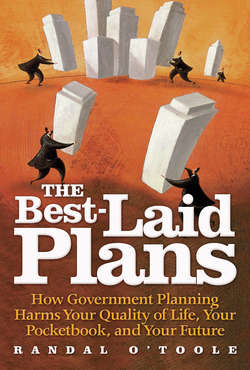Читать книгу The Best-Laid Plans - Randal O'Toole - Страница 9
На сайте Литреса книга снята с продажи.
3. A Process of Natural Selection
ОглавлениеSince many FORPLAN runs supposedly aimed to maximize net economic values, some of the most important data in FORPLAN related to timber prices. To verify these data, I reviewed reports for all timber sales sold by individual forests in the years before my visits. The Forest Service sold timber in auctions, and the bidding was often vigorous. Timber sale reports included the Forest Service’s appraisal, which was used to set a minimum bid, as well as the actual bids made by the various purchasers.
The timber sale reports also revealed something I had not known, which was that the Forest Service was allowed to keep some of the receipts from the timber it sold. Each timber sale report had an entry with the cryptic title of Plan’d SAB Col, which stood for planned sale area betterment collection. This represented the portion of the timber sale’s receipts that the Forest Service expected to keep.
A 1930 law known as the Knutson-Vandenberg Act allowed the Forest Service to keep an unspecified (and therefore unlimited) share of timber receipts for reforestation. The 1976 National Forest Management Act expanded the purposes for which these funds could be used to include wildlife habitat improvements, recreation facilities, or any other “sale area improvements.” This law greatly shaped the Forest Service’s view of the world and how it designed timber sales, because certain designs allowed it to keep more money while others allowed more money to go back to the U.S. Treasury.
In essence, the Knutson-Vandenberg Act encouraged the Forest Service to use timber sales as a fundraising tool for all sorts of forest activities. Would you like to improve wildlife habitat? Plan a timber sale. Want to build a hiking trail? Design another timber sale. Need to repair some of the watershed damage done by past timber sales? Sell more timber.
Detailed K-V documents written for each sale revealed something else: Although the law allowed the Forest Service to spend K-V funds only in the timber sale areas (defined by the Forest Service to include any area within a quarter mile of a cutting unit), the Forest Service actually kept a significant share of K-V funds as “administrative overhead.” After each K-V dollar was spent on the ground, the Washington office of the Forest Service received 4 cents; the regional offices kept about a dime; and the national forest offices kept anywhere from 20 to 50 cents. The result was that about a third of K-V money was actually spent on overhead.
The bureaucracy’s dependence on K-V overhead funds explained Cherry DuLaney’s fake forests. DuLaney did her survey in 1984. In the early 1980s, the timber industry was suffering from a severe recession and was cutting very little national forest timber. This meant there were few opportunities for reforestation, herbicide spraying, or other activities funded by K-V monies. But the Washington and regional offices wrote their budgets three years in advance. Because they did not anticipate the decline in K-V spending, their budgets counted on a continued flow of K-V overhead funds. When the funds didn’t come in, rather than reduce spending, the regional office pressured local reforestation specialists to plant more trees, spray more herbicides, and do other K-V activities.
“Many times, unnecessary projects are proposed and accomplished to finance the personnel to accomplish very necessary jobs such as planning and prework on future projects,” one silviculturist commented.1 This created a chain of incentives: to fund the planners, they had to plant trees, and to plant the trees, they had to sell trees to timber companies.
“The natural tendency of the bureaucracy to maintain and increase its budget provides a strong motivation for the Forest Service to make targets, not on-the-ground needs, the driving force in project work,” I told Representative Jim Weaver’s subcommittee. “Targets are easily budgeted; on-the-ground needs are not, since they are less predictable from year to year. As Mr. Zane Smith testified, the targets are set three years in advance. So targets set in 1979 through 1981, which anticipated high levels of timber cutting and high levels of need for reforestation, were overestimated because in 1982 through 1984 much less timber was cut and fewer acres needed reforestation.” Saying this was not “impugning the integrity of anyone in the Forest Service, which has some of the most honest and well-intentioned employees in the government,” I added. “But honesty and good intentions are not enough; bureaucratic and institutional forces overrule.”2
After the hearing, I realized that the Knutson-Vandenberg Act helped explain many of the other controversies that swirled around the national forests. They included clearcutting, herbicides, roadless areas, below-cost timber sales, and the nondeclining flow policy.
